| View previous topic :: View next topic |
| Author |
Message |
Jon Goodman
Joined: 24 Nov 2010
Posts: 13
|
 Posted: Fri Nov 26, 2010 3:20 pm Post subject: Re-cementing doublet elements with Canadian balsam Posted: Fri Nov 26, 2010 3:20 pm Post subject: Re-cementing doublet elements with Canadian balsam |
 |
|
Jon Goodman wrote:
40 or 50 years ago, Canadian balsam and clear rosin were available at hardware stores, drug stores and even general grocers. At that time, I lived in a small town near the Mexican border, and I had no problem buying either of these products very inexpensively. But things change, don't they? Today it may be difficult to locate many products which were commonly used even 20 years ago.
Well, let's look at Canada balsam. You can still purchase it, but you must know where to look. (hint: The Surplus Shed) A small amount will last you many years. I am still using some I purchased around 1960, and because it is almost gone, I purchased some from the Surplus Shed a few years ago.
Often you will find a lens which looks cloudy or which seems to have many tiny white spots imbedded inside one of the elements. Some people think this is fungus, but if the problem is a cemented doublet, the problem may simply be trouble in the cement. In my experience, fungus does not live in Canadian balsam. An achromatic doublet is 2 pieces of glass used in combination to produce fewer color defects. In almost every case, one element will be flint glass and one will be crown glass. Both glasses have different refractive qualities. Before you do anything, please read everything I have written carefully. Like any process, there are many ways this can be done, and other people may use methods which seem better to them or which are more comfortable to their brains. This is simply how I have learned do it...
A typical cemented doublet with problems:
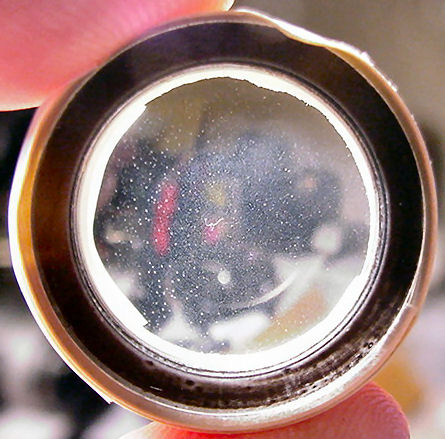
You can see it is quite foggy with white specks that look like falling snow. It also has an odd center spot that looks like a contact lens. Below you see I have taped stiff paper around it to secure the two elements. In order to repair the lens, we must separate these elements first, and since they are going to get hot in the process, I don't want to drop one:
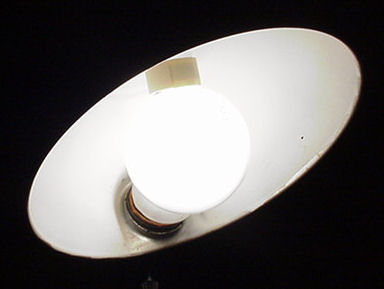
The lens element is now placed on top of my light bulb. It is a 75 watt bulb, and I think either a 60 watt or 100 watt will work also. Leave the doublet on the light bulb for about 10 minutes, remove it using a glove (it will be very hot), push it out of the paper collar and slide the top(crown) element off of the flint element. If you got the doublet hot enough, it should separate quickly and easily:
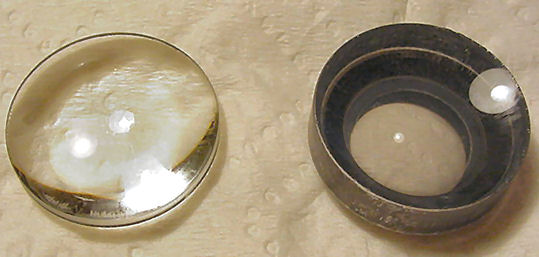
In this case, the flint is darker than the crown. Since this is an old doublet, the flint (concave) probably contains lead. Make a note to yourself about how the two elements fit together. Now clean both elements completely with xylene (xylol), acetone, 100% alcohol or mineral spirits. Clean every bit of old glue from them, and be sure to clean off any lint or dust.
How to make your lens elements really clean? After you clean all the old balsam off your elements, they should be very clear and clean-looking. If you can not make them clear, you can improve them with a non-abrasive polish sold as FLITZ paste. Rub them with a bit of this paste (not too much) and polish with a soft cloth.
Canadian balsam solution:
raw Canada balsam:
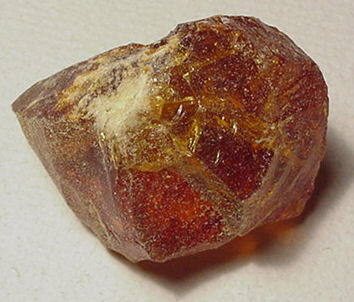
dissolved in xylene (xylol) equals:
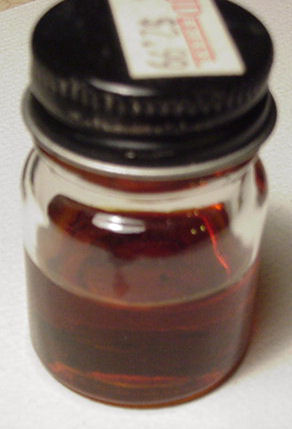
Balsam is similar to rosin, but not identical. In the absence of balsam you can use high grade rosin. You can also use balsam which has been prepared for microscope slide use. There are alternatives: you can use clear epoxy (but I do not like it at all). You can use UV cured cement. It is ok, but it is very expensive and must be used in 4 months or it is no good. Also, you can not easily separate the elements later. If you are going to be working on many old lenses, get some balsam and learn the technique. You will be happy you did. How to make the solution: slowly dissolve balsam in xylene until no more will dissolve. The solution will become relatively the same color as the raw balsam. Store it in a tiny jar. It will never go bad.
Ok, now I will place about 10 drops of balsam solution in the flint element:
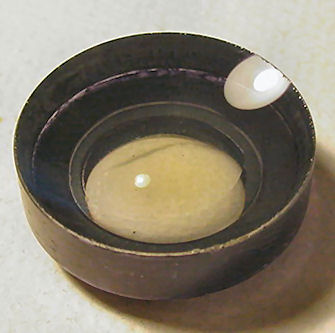
and then I will set the crown element in place. It is better to have too much cement than too little. It may run out of the seam, but this is ok. Remember, we will clean the excess off with solvent after the doublet has dried. How to know if your flint & crown are in line? Use your eyes, your sense of touch and your tongue. Your tongue is capable of sensing very tiny differences in height. When you have the elements in line, set them aside. Do not place the paper sleeve back on them. It will suck balsam out of your joint just like a wick. Leave your doublet undisturbed in a quiet and warm place for a minimum of 1 week and maybe as long as 1 month. A sunny window is good, but do not let your doublet reach a temperature of higher than about 90 degrees F or the solvent in the solution will bubble (a disaster for you as bubbles were probably the problem you were repairing in the first place) Balsam around the edge will dry rather quickly, however the balsam in the very center will take possibly years to dry...and it is possible that it may never dry completely I suppose.
Ok, after your doublet has dried for a week to a month, clean the edges with solvent very carefully (do not allow solvent to go into the seam). Obviously you do not want to disturb the seam because this is where your balsam will be dry.
Now you will notice you have removed the black coloring from around the perimeter of your doublet (if it existed originally). To replace it, use a black felt tip permanent marker (I prefer the brand "Sharpie"). To avoid coloring the glass, place your finger in the depression as you see me doing:
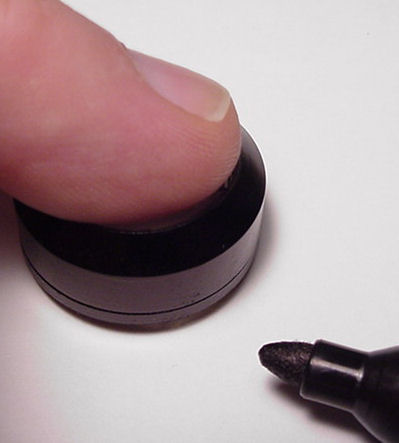
Remember, it is easier to clean your fingertip than to clean ink off of your glass.
Reassemble the elements in your lens and enjoy it.
Jon Goodman, 2010, all rights reserved under US and international copyright laws. |
|
| Back to top |
|
 |
Attila


Joined: 24 Feb 2007
Posts: 57865
Location: Hungary
Expire: 2025-11-18
|
 Posted: Fri Nov 26, 2010 3:28 pm Post subject: Posted: Fri Nov 26, 2010 3:28 pm Post subject: |
 |
|
Attila wrote:
Many thanks for this excellent article!!!
_________________
-------------------------------
Items on sale on Ebay
Sony NEX-7 Carl Zeiss Planar 85mm f1.4, Minolta MD 35mm f1.8, Konica 135mm f2.5, Minolta MD 50mm f1.2, Minolta MD 250mm f5.6, Carl Zeiss Sonnar 180mm f2.8
|
|
| Back to top |
|
 |
Jon Goodman
Joined: 24 Nov 2010
Posts: 13
|
 Posted: Fri Nov 26, 2010 3:35 pm Post subject: Posted: Fri Nov 26, 2010 3:35 pm Post subject: |
 |
|
Jon Goodman wrote:
Happy to do it. One more note: in any lens, you can have cemented doublets and air doublets. In this lens, a cemented doublet and an air doublet created what was designed as a triple lens element.
The third lens nested into the part where my finger is.
Jon |
|
| Back to top |
|
 |
Attila


Joined: 24 Feb 2007
Posts: 57865
Location: Hungary
Expire: 2025-11-18
|
 Posted: Fri Nov 26, 2010 3:38 pm Post subject: Posted: Fri Nov 26, 2010 3:38 pm Post subject: |
 |
|
Attila wrote:
Do you have experience with newer Japanese lenses heating too ? I mean quiet common to see fungus between elements until your post I thought those are un-cleanable by myself due I can't separated elements at home.
I am afraid they did use epoxy rather than balsam...
_________________
-------------------------------
Items on sale on Ebay
Sony NEX-7 Carl Zeiss Planar 85mm f1.4, Minolta MD 35mm f1.8, Konica 135mm f2.5, Minolta MD 50mm f1.2, Minolta MD 250mm f5.6, Carl Zeiss Sonnar 180mm f2.8
|
|
| Back to top |
|
 |
Jon Goodman
Joined: 24 Nov 2010
Posts: 13
|
 Posted: Fri Nov 26, 2010 4:10 pm Post subject: Posted: Fri Nov 26, 2010 4:10 pm Post subject: |
 |
|
Jon Goodman wrote:
The way to know which cement was used is easy: set the element on top of your light bulb (or some people will use hot water or a warm oven) and then you can know what cement was used. I prefer a light bulb because it is quicker and more economical. Also, you will not overheat the lens. If the elements were joined with epoxy, they usually will not separate with heat. If the elements were joined with UV cured cement, well...you can separate them, but it is not easy. I think methylene chloride may be the best thing to use, but it is very difficult to find. Some people tell me paint remover will dissolve UV cement, but it has not worked for me.
Epoxy is difficult because solvents do not dissolve it very well (if at all in some cases). I have seen some Japanese elements joined with something that behaves like a silicone adhesive. I am not certain what it is, really. Over time, it turns very milky. You can pull the two elements apart, but heat does not affect this stuff and solvents are useless when it is dry. Balsam was used longer than some people think.
Jon |
|
| Back to top |
|
 |
Attila


Joined: 24 Feb 2007
Posts: 57865
Location: Hungary
Expire: 2025-11-18
|
 Posted: Fri Nov 26, 2010 4:18 pm Post subject: Posted: Fri Nov 26, 2010 4:18 pm Post subject: |
 |
|
Attila wrote:
| Jon Goodman wrote: |
The way to know which cement was used is easy: set the element on top of your light bulb (or some people will use hot water or a warm oven) and then you can know what cement was used. I prefer a light bulb because it is quicker and more economical. Also, you will not overheat the lens. If the elements were joined with epoxy, they usually will not separate with heat. If the elements were joined with UV cured cement, well...you can separate them, but it is not easy. I think methylene chloride may be the best thing to use, but it is very difficult to find. Some people tell me paint remover will dissolve UV cement, but it has not worked for me.
Epoxy is difficult because solvents do not dissolve it very well (if at all in some cases). I have seen some Japanese elements joined with something that behaves like a silicone adhesive. I am not certain what it is, really. Over time, it turns very milky. You can pull the two elements apart, but heat does not affect this stuff and solvents are useless when it is dry. Balsam was used longer than some people think.
Jon |
Thank you!
_________________
-------------------------------
Items on sale on Ebay
Sony NEX-7 Carl Zeiss Planar 85mm f1.4, Minolta MD 35mm f1.8, Konica 135mm f2.5, Minolta MD 50mm f1.2, Minolta MD 250mm f5.6, Carl Zeiss Sonnar 180mm f2.8
|
|
| Back to top |
|
 |
ludoo


Joined: 18 Sep 2009
Posts: 1397
Location: Milan, Italy
Expire: 2011-12-05
|
 Posted: Fri Nov 26, 2010 5:00 pm Post subject: Posted: Fri Nov 26, 2010 5:00 pm Post subject: |
 |
|
ludoo wrote:
Jon, I got some liquid Canada Balsam lat year from ebay, sold for microscopes use, and it's a warm yellow color instead of the red in your picture. Do you think it's the same stuff?
_________________
My galleries
Digital: Samsung EX-1
Past Digital: Samsung NX10, Sigma SD9, Sigma SD10, SD14, DP2, Pentax *istD, Kx, Fuji S2 Pro, Canon 5D
Analog: packfilm Polaroids, 6x9 Kodak folders, Pentacon Taxona half-frame, Fujica ST605n, Walz Envoy, Olympus 35 S-II, Olympus Wide S
Past Analog: Polaroid 600se, Polaroid 110B, Canon IIF, various fixed-lens and Russian rangefinders, ...
Past Lenses: Nikkor 24/2.8, Nikkor SC 50/1.4, Nikkor 50/2, Nikkor H 85/1.8, Nikkor P 105/2.5, Nikkor Q 135/3.5, Fujinon 100/2.8, Fujinon EBC 100/2.8, Fujinon EBC 135/3.5, Fujinon EBC 200/4.5, Mamiya SX 135/2.8, CZJ Flektogon 35/2.4, CZJ Pancolar 50/1.8 zebra, CZJ Sonnar 135/3.5, ...
altroformato
|
|
| Back to top |
|
 |
Sevo

Joined: 22 Aug 2008
Posts: 1189
Location: Frankfurt, Germany
Expire: 2012-12-03
|
 Posted: Fri Nov 26, 2010 5:26 pm Post subject: Posted: Fri Nov 26, 2010 5:26 pm Post subject: |
 |
|
Sevo wrote:
It can be (and often is) bleached. By the way, industrially lenses were generally cemented with the (molten) rosin, as that saves the drying period. But that means heating and cooling the lenses evenly and handling the lenses while hot - which is not entirely easy without dedicated tools.
_________________
Sevo |
|
| Back to top |
|
 |
Jon Goodman
Joined: 24 Nov 2010
Posts: 13
|
 Posted: Fri Nov 26, 2010 6:32 pm Post subject: Posted: Fri Nov 26, 2010 6:32 pm Post subject: |
 |
|
Jon Goodman wrote:
Yes, it probably is the same thing. Balsam for use in microscope slides is not as concentrated as the solution I have made, however. You know on a slide you will have the cover glass, and it is very small. So the balsam can dry more quickly and it can be thinner in concentration. On a lens you have a space of air which is hundredths of a mm in thickness, and then of course you have difficulty in making that dry because once the balsam on the perimeter is dry, no air will go to the center. Sevo's comment is good. Balsam used commercially is filtered and bleached. But it is not necessary for home use. Any impurity will drop to the bottom, and even very dark balsam will appear clear when it dries because you have such a thin layer. Besides, it is very difficult to filter a balsam solution without specialty equipment.
I have seen people paint both sides of the lens elements with balsam, let them dry and then put the two in an oven to heat them and melt the balsam letting the lens fall into place with gravity. This elminates the drying period entirely. But...and this is very important...you must use a metal "V" appliance to align the two lens elements. For hobby use, I think the method I have shown is probably the best. Handling a hot lens element is not fun.
Jon |
|
| Back to top |
|
 |
sadness

Joined: 16 Aug 2010
Posts: 49
Location: Constanta, Romania
|
 Posted: Fri Nov 26, 2010 7:40 pm Post subject: Posted: Fri Nov 26, 2010 7:40 pm Post subject: |
 |
|
sadness wrote:
Many thanks for the great tips. Also I have some questions if you don't mind.
1. From what I have heard Canada Balsam is not used on newer lenses, but I have managed to separate a doublet from a pentacon 200mm wich is a rather new lens and not using a lot of heat either.
2. What level of IQ degradation I should expect if I don't re-cement but just place them in their place and tight them with the screw ? From first glance no major degradation is taking place but I just took few test shots, and didn't test the lens before.
3. They should be symmetrical so the only alignment should be not to have them off-centered I think, is it ?
4. Where from can this Canada Balsam in solid form be bought from internet if there is any place, or maybe not solid form but good quality ?
_________________
My site motorai.ro as motorcycle addict, I post on the blog of the site.
casti moto piese moto accesorii moto echipamente moto |
|
| Back to top |
|
 |
indianadinos


Joined: 06 Jul 2008
Posts: 1310
Location: Toulouse, France
Expire: 2011-12-05
|
 Posted: Fri Nov 26, 2010 8:25 pm Post subject: Posted: Fri Nov 26, 2010 8:25 pm Post subject: |
 |
|
indianadinos wrote:
Hi,
Many thanks for this great tutorial ...
Now, i have another question for you: suppose i have a doublet cemented with UV cured resin and that i manage to separate them (never done, but, who knows ...). Would the optical quality be the same if i replace the original UV cured resin with Canada Balsam ? Or, more generally speaking, does the kind of resin used to glue elements have an impact on IQ ?
Cheers
_________________
Please visit my blogs Shooting with a Pentax K10D / FF Visions
Takumar: 24/3.5, 28/3.5, 35/2, 35/3.5, 50/1.4, 55/1.8, 85/1.8, 105/2.8, 120/2.8, 135/3.5, 150/4, 200/4
Pentax-K: M28/2.8, K28/3.5, M50/1.4, A50/1.7, M50/4 Macro, K85/1.8, K105/2.8, K135/2.5, M200/4, M70-150/4
Zeiss: Flektogon 20/2.8, 20/4, 35/2.4, 35/2.8, Tessar 50/2.8, Pancolar 50/1.8, Biotar 58/2, Sonnar 135/3.5, Sonnar 180/2.8
Meyer: Primagon 35/4.5, Domiplan 50/2.8, Oreston 50/1.8, Primoplan 58/1.9, Trioplan 100/2.8, Orestor 100/2.8, Orestor 135/2.8
Schacht/Steinheil: Travenar 90/2.8, Travenon 135/4.5, Quinar 135/2.8, Quinar 135/3.5
Russian: MIR 37B, Industar 50/3.5, Helios 44M & 44M-2, Jupiter 37A
P6: Flektogon 50/4, Biometar 80/2.8, Orestor 300/4
Nikkor: Nikkor-O 35/2, Micro 55/3.5, Nikkor-S 50/1.4, Nikkor-Q 135/2.8
Fuji: EBC 28/3.5, EBC 55/3.5 Macro, EBC 135/2.5
Misc Lenses: Kiron 105/2.8 Macro, Tamron SP90/2.5
... and a few other Vivitar, Tamron, Sigma and Soligor lenses ...
|
|
| Back to top |
|
 |
visualopsins


Joined: 05 Mar 2009
Posts: 11069
Location: California
Expire: 2025-04-11
|
 Posted: Fri Nov 26, 2010 8:46 pm Post subject: Posted: Fri Nov 26, 2010 8:46 pm Post subject: |
 |
|
visualopsins wrote:
Good work! Nice presentation too. Proof it can be done. May I ask the focal length of lens? I think a wider-angle lens group might be easier to align than a longer lens.
Optical Cements
_________________
☮☮☮☮☮☮☮☮☮☮☮☮☮☮☮☮☮☮☮☮☮☮☮☮☮☮☮☮☮☮☮☮ like attracts like! ☮☮☮☮☮☮☮☮☮☮☮☮☮☮☮☮☮☮☮☮☮☮☮☮☮☮☮☮☮☮☮☮
Cameras: Sony ILCE-7RM2, Spotmatics II, F, and ESII, Nikon P4
Lenses:
M42 Asahi Optical Co., Takumar 1:4 f=35mm, 1:2 f=58mm (Sonnar), 1:2.4 f=58mm (Heliar), 1:2.2 f=55mm (Gaussian), 1:2.8 f=105mm (Model I), 1:2.8/105 (Model II), 1:5.6/200, Tele-Takumar 1:5.6/200, 1:6.3/300, Macro-Takumar 1:4/50, Auto-Takumar 1:2.3 f=35, 1:1.8 f=55mm, 1:2.2 f=55mm, Super-TAKUMAR 1:3.5/28 (fat), 1:2/35 (Fat), 1:1.4/50 (8-element), Super-Multi-Coated Fisheye-TAKUMAR 1:4/17, Super-Multi-Coated TAKUMAR 1:4.5/20, 1:3.5/24, 1:3.5/28, 1:2/35, 1:3.5/35, 1:1.8/85, 1:1.9/85 1:2.8/105, 1:3.5/135, 1:2.5/135 (II), 1:4/150, 1:4/200, 1:4/300, 1:4.5/500, Super-Multi-Coated Macro-TAKUMAR 1:4/50, 1:4/100, Super-Multi-Coated Bellows-TAKUMAR 1:4/100, SMC TAKUMAR 1:1.4/50, 1:1.8/55
M42 Carl Zeiss Jena Flektogon 2.4/35
Contax Carl Zeiss Vario-Sonnar T* 28-70mm F3.5-4.5
Pentax K-mount SMC PENTAX-A ZOOM 1:3.5 35~105mm, SMC PENTAX ZOOM 1:4 45~125mm
Nikon Micro-NIKKOR-P-C Auto 1:3.5 f=55mm, NIKKOR-P Auto 105mm f/2.5 Pre-AI (Sonnar), Micro-NIKKOR 105mm 1:4 AI, NIKKOR AI-S 35-135mm f/3,5-4,5
Tamron SP 17mm f/3.5 (51B), Tamron SP 17mm f/3.5 (151B), SP 500mm f/8 (55BB), SP 70-210mm f/3.5 (19AH)
Vivitar 100mm 1:2.8 MC 1:1 Macro Telephoto (Kiron)
|
|
| Back to top |
|
 |
Jon Goodman
Joined: 24 Nov 2010
Posts: 13
|
 Posted: Fri Nov 26, 2010 11:39 pm Post subject: Posted: Fri Nov 26, 2010 11:39 pm Post subject: |
 |
|
Jon Goodman wrote:
Thank you for the compliments.
Answers...in random order.
This was a 35mm lens, but I have not experienced more difficulty with longer focal lengths. Achromatic doublets share many similarities. Actually I think you may find them more commonly in focal lengths below 90mm. As for the alignment, please remember you will be dealing with two circles which are the same. You can make a V to use if you are worried. You only need to hacksaw a one inch section of angle aluminum and you will have what you need...you know it will form an L shape, and if the sides are correct and true, you can use it. (If two points on the perimeter of two equal circles match, all other points will be the same, too.
Converting a cemented doublet to an air doublet. If you can separate the elements, you can try this. If you get no color problems or image problems, then it will be ok for you. Sometimes the two elements need that hair of space that the cement provides. Balsam has a very nice optical quality. You can generally use balsam in place of any other material as far as I know.
You can buy it (or at least the last I knew they still had some) at The Surplus Shed. Do you know about this seller? Here is a link: http://www.surplusshed.com You can find many lens supplies here. The Surplus Shed will advise you to heat the balsam when using it, but if you have time to wait, I think allowing it to dry undisturbed is better.
Jon |
|
| Back to top |
|
 |
Jon Goodman
Joined: 24 Nov 2010
Posts: 13
|
 Posted: Fri Nov 26, 2010 11:46 pm Post subject: Posted: Fri Nov 26, 2010 11:46 pm Post subject: |
 |
|
Jon Goodman wrote:
Interesting...my message did not post.
Thank you for the compliments.
Answers in random order:
yes, you can convert a cemented doublet to an air doublet, and in some cases it will be ok. In other cases it may need that hair of space between the elements provided by the balsam to be ok.
balsam can be used in place of any other compound. It probably isn't used as much anymore, but I've worked on some lenses which were not very old that were assembled using it or a product which behaved exactly like it.
You can purchase it at the Surplus Shed. You can find them on Google. They sell all kinds of neat things.
The kind of cement will have an impact on image quality...but in most cases it will be slight.
Jon |
|
| Back to top |
|
 |
Attila


Joined: 24 Feb 2007
Posts: 57865
Location: Hungary
Expire: 2025-11-18
|
 Posted: Sat Nov 27, 2010 12:15 am Post subject: Posted: Sat Nov 27, 2010 12:15 am Post subject: |
 |
|
Attila wrote:
I did remove URL TAG and now showed up, I think we have a bug in forum software, don't use URL TAG for a simple URL just put pure url it will be linked fine.
_________________
-------------------------------
Items on sale on Ebay
Sony NEX-7 Carl Zeiss Planar 85mm f1.4, Minolta MD 35mm f1.8, Konica 135mm f2.5, Minolta MD 50mm f1.2, Minolta MD 250mm f5.6, Carl Zeiss Sonnar 180mm f2.8
|
|
| Back to top |
|
 |
CarbonR


Joined: 31 Dec 2008
Posts: 1969
Location: Clermont-Ferrand, France
|
 Posted: Sat Nov 27, 2010 8:17 am Post subject: Posted: Sat Nov 27, 2010 8:17 am Post subject: |
 |
|
CarbonR wrote:
I suppose that for cemented triplets, we should "glue" two lenses first, then add the third one ?
BTW, nice explanation, I saw something like this in french, but with less explanations : http://www.suaudeau.eu/memo/rep/recollage_lentilles.html
Here he heats up the basalm to 70°C for 10 minutes to dry the basalm.
_________________
Cameras : Canon 5D, Pentax K100D, Pentax 6x7, Spotmatic
Lenses : 15mm to 1000mm (24x36)
My websites : [FR & ENG]Takumar - the eyes of the Spotmatic : info about all Takumar lenses // Kogaku - My photo site
I am selling : Takumar lenses and rare Pentax bodies, pm me if you're interested in something [MFLenses feed-back]
Information on Takumar lenses with samples :
Wide angle : Takumar 15/3.5 15mm, Takumar 17/4 17mm, Takumar 18/11 18mm, Takumar 20/4.5 20mm, Takumar 24/3.5 24mm, Takumar 28/3.5 V1 28mm, Takumar 28/3.5 V2 28mm, Takumar 35/2 V1 35mm, Takumar 35/2 V2 35mm, Takumar 35/2.3 35mm, Takumar 35/3.5 35mm, Takumar 35/4 35mm
Standard : Takumar 50/1.4 V1 50mm, Takumar 50/1.4 V2 50mm, Takumar 50/3.5 50mm, Takumar 50/4 50mm, Takumar 55/2 55/1.8 55mm, Takumar 55/2.2 V1 55mm, Takumar 55/2.2 V2 55mm, Takumar 58/2 58mm, Takumar 58/2.4 58mm
Short tele : Takumar 83/1.9 83mm, Takumar 85/1.8 85/1.9 85mm, Takumar 85/1.8 85mm, Takumar 100/2 100mm, Takumar 100/3.5 100mm, Takumar 100/4 100mm, Takumar 105/2.8 V1 105mm, Takumar 105/2.8 V2 105mm, Takumar 120/2.8 120mm
Telephoto : Takumar 135/2.5 V1 135mm, Takumar 135/2.5 V2 135mm, Takumar 135/3.5 V1 135mm, Takumar 135/3.5 V2 135mm, Takumar 150/4 V1 150mm, Takumar 150/4 V2 150mm
Long tele : Takumar 200/3.5 200mm, Takumar 200/4 200mm, Takumar 200/5.6 200mm, Takumar 300/4 V1 300mm, Takumar 300/4 V2 300mm, Takumar 300/4 V3 300mm, Takumar 300/6.3 300mm, Takumar 400/5.6 400mm, Takumar 500/4.5 500mm, Takumar 500/5 500mm, Takumar 1000/8 V1 1000mm, Takumar 1000/8 V2 1000mm
Zoom : Zoom-Takumar 45~125/4 , Zoom-Takumar 70~150/4.5 , Zoom-Takumar 85~210/4.5 , Zoom-Takumar 135~600/6.7
Achromatic : Ultra-Achromatic-Takumar 85/4.5 , Ultra-Achromatic-Takumar 300/5.6 300mm |
|
| Back to top |
|
 |
Jon Goodman
Joined: 24 Nov 2010
Posts: 13
|
 Posted: Sat Nov 27, 2010 8:33 pm Post subject: Posted: Sat Nov 27, 2010 8:33 pm Post subject: |
 |
|
Jon Goodman wrote:
Thank you for the link and the compliment. Some people prefer to heat the balsam but in my experience, this creates bubbles unless the heat is very low...maybe 30 degrees C or 85 degrees F...something like that. The bubbles are not good. The balsam will naturally dry at the edges first, and if you have bubbles, they can be trapped as the edges cool and the center remains hot. Yes, for triplets, since I do not use heat, sequence does not matter. I will do one set of 2 elements first and then when I think it is dry I will cement the final element.
Jon |
|
| Back to top |
|
 |
kuuan


Joined: 14 Jan 2008
Posts: 4569
Location: right now: Austria
Expire: 2014-12-26
|
 Posted: Sat Aug 23, 2014 12:01 pm Post subject: Posted: Sat Aug 23, 2014 12:01 pm Post subject: |
 |
|
kuuan wrote:
This beautifully presented and precise instructions, this document is a publication which is more than just a 'sticky', better it was at least that in this forum!
thank you very much for this Jon
_________________
my photos on flickr: https://www.flickr.com/photos/kuuan/collections |
|
| Back to top |
|
 |
|
|
